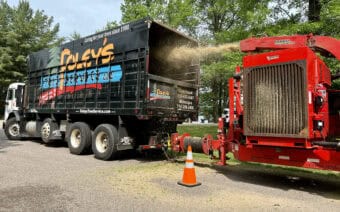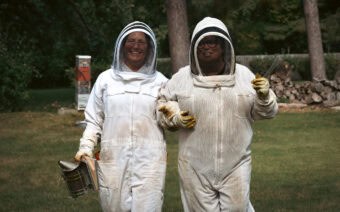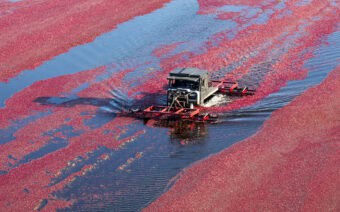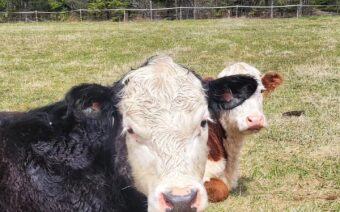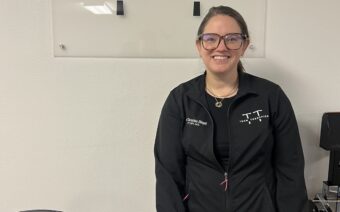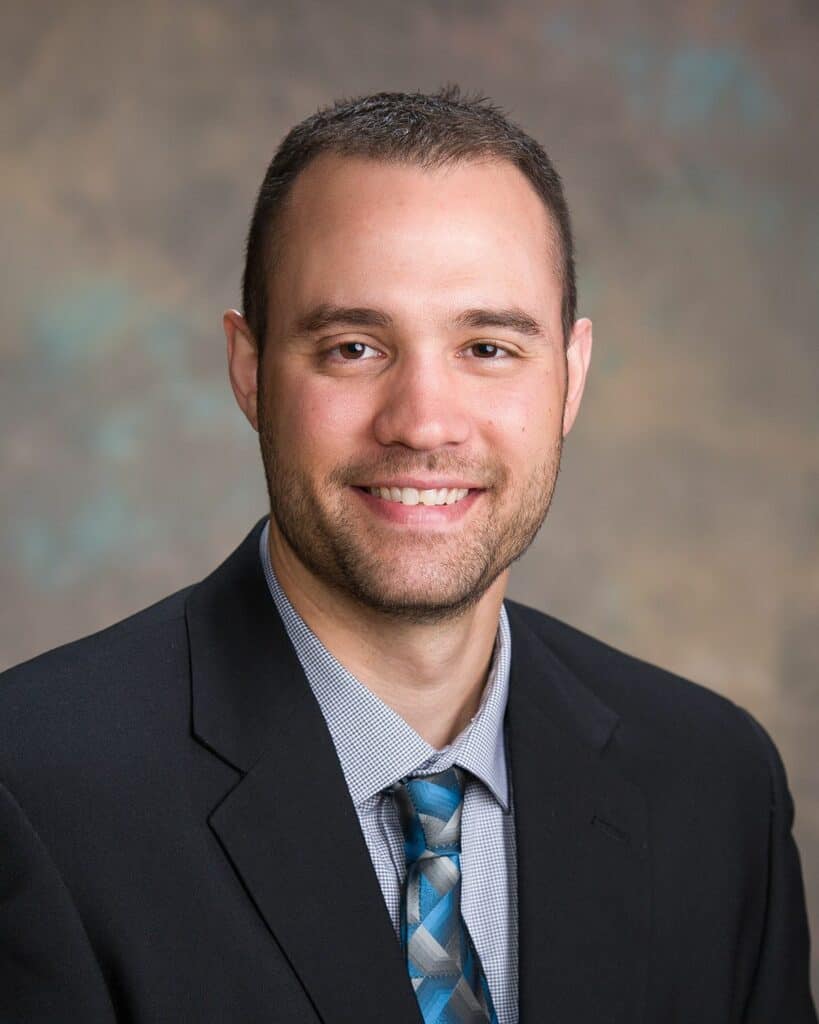
August 5, 2024
MARSHFIELD – According to an old adage, “if you want something done – ask a busy person.”
In the case of improving safety for farmers and their families, Dr. Bryan Weichelt said he is that busy person.
Weichelt said his career has entailed earning his doctorate, eight years of military service, more than a decade of intensive research science at the Marshfield Clinic Research Institute’s National Farm Medicine Center, maintaining the website AgInjuryNews.org, additional research for the U.S. Department of Veterans Affairs, two summers of farming, founding a farmers market and operating a storage facility and other commercial real estate – all while raising five children with his wife, Stacey.
“Like most parents, I’m driven every day by the hopes and dreams of a great future for my kids,” Weichelt said. “If you want to do big things you have to put in the work. You have to dedicate the time – you have to take risks.”
In 2024, as part of his effort toward achieving a greater future for the agricultural industry, Weichelt said he applied for the Steve J. Miller Distinguished Physician/Scientist Endowment in Rural and Agricultural Health and Safety Research.
The three-year endowment “recognizes excellence in medical research, education and clinical care and provides resources to encourage the recipients of the awards to continue their contributions to the institution.”
Earlier this year, Weichelt was announced as the selected recipient.
“It was great to hear – certainly appreciated,” he said. “It always feels good to be recognized for your hard work, and something with this type of prestige feels great. I’m certainly honored to have received it, and it comes with some funding to expand my work a bit more on AgInjuryNews and data analyses.”
Agricultural health
Weichelt said he grew up on a small Wisconsin dairy farm “feeding calves, milking cows, scraping manure and driving tractor – the whole bit.”
“My parents are still on the farm,” he said. “I’m glad to have (agriculture) in my life, but I’m also glad I’m not waking up every day at 5 a.m., milking cows when it’s 20-below or when it’s 90 degrees outside. I certainly have a lot of empathy and appreciation for those who pursue that as a career path.”
Weichelt said he stays somewhat involved with his parents’ farm, has rented his own land to grow direct-to-consumer hay, has co-founded and directed a farmers market with his wife and presently maintains a large garden and produces maple syrup.
But for the most part, Weichelt said he works on the industry rather than in it – channeling his empathy for farmers into the broader scope of improving agricultural health.
Much of his focus, he said, is devoted to agricultural injury surveillance.
Federal surveillance for this industry, Weichelt said, has historically been difficult compared to others due to some of the unique aspects of agriculture, such as officially defining what is an occupation and what constitutes work in a round-the-clock, home-based operation.
Another relative anomaly, he said, is the common presence and contribution of children on a farm.
“You don’t see a lot of children driving backhoes on construction sites, but you see a lot of children driving tractors and skid steers or farm equipment – not just in the U.S. but abroad,” he said. “There’s a lot of agricultural exceptionalism around children and youth and even hired workers. There’s a lot less regulation, and there are a lot more injuries and fatalities. A child dies on a farm every three days in the U.S.”
To improve awareness and vigilance regarding farm safety, Weichelt said he began running AgInjuryNews about 10 years ago.
He said, at the time, one of his mentors at the National Farm Center – Dr. Barbara Lee, director of the National Children’s Center for Rural and Agricultural Health and Safety – tasked him with taking on the digital project.
“They were still collecting newspaper clippings in a binder,” he said. “I had the vision of making something more publically available and accessible for anyone, anywhere, anytime – and it took off and grew. Our staff and folks working on it in Marshfield have put a lot of dedicated time into combing through reports, coding them and entering them into the system.”
Weichelt said the website – which has grown to become the world’s largest public-facing dataset of agricultural traumatic injury reports – provides a resource for tracking accidents across the United States and Canada, informing farm workers and agents from the U.S. Bureau of Labor Statistics.
“We have about 2,000 subscribers who sign on to receive regular alerts and updates from the system,” he said. “Not the most uplifting read on a Monday morning, but anecdotally, we’ve had several reports that say this is one of the things that keeps people motivated in the field – to do what they do to try to prevent injuries and fatalities among children and adults and workers.”
Weichelt said beyond AgInjuryNews, at a given time, he handles anywhere from six to 10 research projects based on improving agricultural safety.
Some of his work, he said, is more focused on intensive research, while other projects center on community outreach – such as his program to distribute slow-moving vehicle signs to better prevent road accidents.
One five-year study through the National Children’s Center Weichelt said he’s been part of aims to determine the impact reports – such as those from AgInjuryNews may have upon farm parents and agricultural educators, teachers and Future Farmers of America advisors.
“Reading news reports as an intervention – does it change the way people behave?” Weichelt said regarding what the study hopes to answer. “What’s the appropriate dose and timing? How many times do you need to read it? And what age would be more effective? lf I have 17- and 18-year-old kids reading about a two-year-old, that may not change my behavior as a parent of teenagers.”
Even though the number of farms across the country has reduced or been consolidated, Weichelt said fighting for farm safety is as important as ever.
“By and large, the injury rates haven’t changed a whole lot – meaning farms haven’t gotten a whole lot safer in the last 10-(15) years,” he said. “I think there are still an estimated 2.2 million farms in the U.S., and there’s always something to be learned about our international colleagues and types of successes they’ve had with injury prevention, programming and policy. I think there continues to be a lot of opportunity.”
The Miller Endowment
Weichelt said the paradox of health research work is it’s typically not profitable – even when its findings are invaluable.
The Miller Endowment was named through a gift from the late Marbeth Spreyer – a Marshfield native – to the Marshfield Clinic Health System and Marshfield Clinic Research Institute in memory of her father, Steve J. Miller – a cheese wholesaler in Marshfield who knew all the clinic doctors and was interested in supporting research as far back as 1959.
The endowment application, Weichelt said, includes a curriculum vitae, list of noteworthy accomplishments, a personal statement and a scope of work.
Regarding the latter, he said what an applicant intends to do with the funding is “arguably as important as past accomplishments.”
Being selected by a committee from a pool of an unknown number of applicants, he said, was an honor – one he said invokes gratitude and solemnity.
“It’s an interesting and unique field to be employed in – in research, in government and some other entities – where your salary and your program is often taxpayer funded,” he said. “At least for me, I have this sense of responsibility – I owe it to whoever paid for this, whoever’s dollars these are – to do my best and to put forth the effort and do good, quality work.
Weichelt said he feels that same way – “if not more” – with donor-funded programs and projects like this endowment.
“I feel like I owe it to them, their legacy and their memory to continue to perform and deliver what I said I would do, and go above and beyond that,” he said. “It is a weird feeling versus taking out a loan and starting a business. If you’re on your own and you take out a loan and you don’t make it, it’s on you. When you borrow somebody’s money to do that – if you borrow grandma’s money – you maybe feel differently about it. A little more pressure, almost.”
In addition to expanding his training and research and advancing science and policy at the state and federal level, Weichelt said the Miller Endowment also supports his efforts to improve the lives of fellow military veterans.
He said since a large number of veterans go into farming, there is some incidental connection between agricultural and service members, though the connection isn’t necessary.
“Research scientists can pursue a topic of interest if it fits within the institute and health system – and certainly care and health-related topics around veterans is also within that umbrella,” he said. “The project that’s funded is to interview vets across the northern half of the state of Wisconsin – which is (the Marshfield Clinic) service area – and get a better understanding of what veterans know or don’t know about the available programs and benefits and opportunities including V.A.-funded health care at community care providers – which was a new thing for hundreds of thousands of vets since the passing of the PACT Act in recent years.”
A greater future
The Miller Endowment is awarded for a term of three years and is renewable for an additional three-year team based on accomplishment.
“If you do what you say you’re going to do – and exceed that – you should be in good shape to compete for another three years (of funding),” Weichelt said.
Looking ahead three, six or however many years, Weichelt said his work ethic will forever be driven by the people in his life, including his colleagues.
“Anywhere you work – any organization, the military, hospitals, police departments, research centers – wherever it is, it’s usually about the people,” he said. “That’s what inspires you and keeps you going. I’m not just blowing smoke here – we’ve got a great group of people who work in this field and in this (agricultural health) discipline across the country and across the globe.”
Additionally, Weichelt said he is motivated by his family.
“My wife, Stacey – who I cannot say enough about – she’s more than anyone could hope to have in their life,” he said. “My best friend and partner through it all. We are fortunate to have five awesome kiddos – two of whom have some serious health needs that require much attention, therapy and care. I’m sure that extra responsibility plays a role, subconsciously driving my productivity as well. All that said, I’m not on an island working all alone. I’m surrounded – professionally and personally – by some brilliant minds, inspiring leaders and hard-working friends and family.”
 Just dropping by: Odyssey Climbing + Fitness in Ashwaubenon
Just dropping by: Odyssey Climbing + Fitness in Ashwaubenon TitletownTech announces extension of expertise to Milwaukee
TitletownTech announces extension of expertise to Milwaukee


